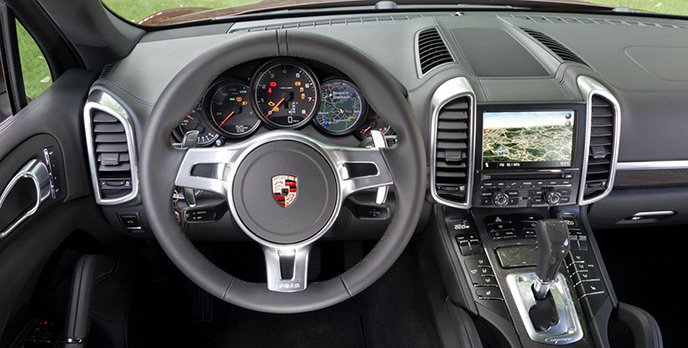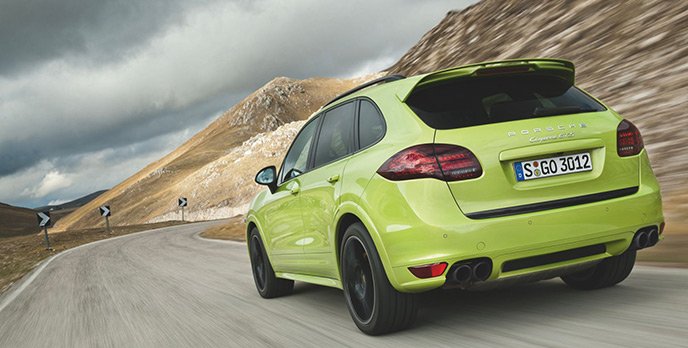Porsche celebrates 20 years of the Cayenne
08 Sep 2022|1,049 views
Development of the original Porsche Cayenne proved to be a difficult one. Michael Mauer, who was responsible for the design of Porsche models, wanted to take the idea of the Cayenne further. However, challenges such as having doors identical to those on the VW Touareg sister model were present, thus limiting design options.
Fortunately, the huge success of the first-generation Cayenne gave designers more room for creative freedom for the second-generation's design.
At the front, exterior mirrors were moved from the window corner to the shoulder of the door, creating a more dynamic look while making space for additional quarter lights. The design of the roof was also modified to make the car look fast even when it was stationary.
The driver's seating position was also modified from the first generation, allowing the driver to have the sensation of being in a more driver focused cockpit as opposed to sitting on top of the car. This effect was underscored by the centre console rising towards the front which was based on the design of the centre console in the Panamera.
The second-generation Cayenne also gave Porsche the opportunity to use its own instrument cluster, with the rev counter in the middle, a traditional Porsche trademark. The steering wheel was also borrowed from the iconic 911. Mauer believed this helped to lessen the disconnect between the 911 and Cayenne for customers who owned both cars.
Being Porsche, the technical aspect of the car was sure to be improved on. The low-range gearbox present in the first generation Cayenne which gave it great off-road prowess while maintaining on-road performance was removed.
It was replaced by a unit which did away with the transfer case and low-range gear, reducing weight while improving control quality, speed and off-road capability.
Porsche also pursued a more lightweight construction for the second-generation Cayenne, shaving off 111kg from the body, with 39kg being saved in the flaps and doors alone. The tailgate was also made entirely out of aluminium to save weight.
Fortunately, the huge success of the first-generation Cayenne gave designers more room for creative freedom for the second-generation's design.
At the front, exterior mirrors were moved from the window corner to the shoulder of the door, creating a more dynamic look while making space for additional quarter lights. The design of the roof was also modified to make the car look fast even when it was stationary.
The driver's seating position was also modified from the first generation, allowing the driver to have the sensation of being in a more driver focused cockpit as opposed to sitting on top of the car. This effect was underscored by the centre console rising towards the front which was based on the design of the centre console in the Panamera.
The second-generation Cayenne also gave Porsche the opportunity to use its own instrument cluster, with the rev counter in the middle, a traditional Porsche trademark. The steering wheel was also borrowed from the iconic 911. Mauer believed this helped to lessen the disconnect between the 911 and Cayenne for customers who owned both cars.
Being Porsche, the technical aspect of the car was sure to be improved on. The low-range gearbox present in the first generation Cayenne which gave it great off-road prowess while maintaining on-road performance was removed.
It was replaced by a unit which did away with the transfer case and low-range gear, reducing weight while improving control quality, speed and off-road capability.
Porsche also pursued a more lightweight construction for the second-generation Cayenne, shaving off 111kg from the body, with 39kg being saved in the flaps and doors alone. The tailgate was also made entirely out of aluminium to save weight.
Development of the original Porsche Cayenne proved to be a difficult one. Michael Mauer, who was responsible for the design of Porsche models, wanted to take the idea of the Cayenne further. However, challenges such as having doors identical to those on the VW Touareg sister model were present, thus limiting design options.
Fortunately, the huge success of the first-generation Cayenne gave designers more room for creative freedom for the second-generation's design.
At the front, exterior mirrors were moved from the window corner to the shoulder of the door, creating a more dynamic look while making space for additional quarter lights. The design of the roof was also modified to make the car look fast even when it was stationary.
The driver's seating position was also modified from the first generation, allowing the driver to have the sensation of being in a more driver focused cockpit as opposed to sitting on top of the car. This effect was underscored by the centre console rising towards the front which was based on the design of the centre console in the Panamera.
The second-generation Cayenne also gave Porsche the opportunity to use its own instrument cluster, with the rev counter in the middle, a traditional Porsche trademark. The steering wheel was also borrowed from the iconic 911. Mauer believed this helped to lessen the disconnect between the 911 and Cayenne for customers who owned both cars.
Being Porsche, the technical aspect of the car was sure to be improved on. The low-range gearbox present in the first generation Cayenne which gave it great off-road prowess while maintaining on-road performance was removed.
It was replaced by a unit which did away with the transfer case and low-range gear, reducing weight while improving control quality, speed and off-road capability.
Porsche also pursued a more lightweight construction for the second-generation Cayenne, shaving off 111kg from the body, with 39kg being saved in the flaps and doors alone. The tailgate was also made entirely out of aluminium to save weight.
Fortunately, the huge success of the first-generation Cayenne gave designers more room for creative freedom for the second-generation's design.
At the front, exterior mirrors were moved from the window corner to the shoulder of the door, creating a more dynamic look while making space for additional quarter lights. The design of the roof was also modified to make the car look fast even when it was stationary.
The driver's seating position was also modified from the first generation, allowing the driver to have the sensation of being in a more driver focused cockpit as opposed to sitting on top of the car. This effect was underscored by the centre console rising towards the front which was based on the design of the centre console in the Panamera.
The second-generation Cayenne also gave Porsche the opportunity to use its own instrument cluster, with the rev counter in the middle, a traditional Porsche trademark. The steering wheel was also borrowed from the iconic 911. Mauer believed this helped to lessen the disconnect between the 911 and Cayenne for customers who owned both cars.
Being Porsche, the technical aspect of the car was sure to be improved on. The low-range gearbox present in the first generation Cayenne which gave it great off-road prowess while maintaining on-road performance was removed.
It was replaced by a unit which did away with the transfer case and low-range gear, reducing weight while improving control quality, speed and off-road capability.
Porsche also pursued a more lightweight construction for the second-generation Cayenne, shaving off 111kg from the body, with 39kg being saved in the flaps and doors alone. The tailgate was also made entirely out of aluminium to save weight.
Latest COE Prices
November 2025 | 1st BIDDING
NEXT TENDER: 19 Nov 2025
CAT A$110,002
CAT B$115,001
CAT C$76,000
CAT E$121,010
View Full Results Thank You For Your Subscription.























